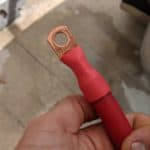
MENUMENU
TALK TO AN EXPERT
Special Hours: 7AM – 6PM PST
TALK TO AN EXPERT
Special Hours: 7AM – 6PM PST
For many, a life off the grid is a dream that offers self-reliance, time in nature, and a chance to disconnect. But living without traditional electric, water, and sewer systems can present some challenges too. For those living in colder climates, among the most serious of these is staying warm during the fall and winter months. Off-grid heating isn’t as simple as traditional heating methods. Let’s look at the challenges and the best off-grid heating methods.

Whether you have a traditional home or need an off-grid heating solution, there’s one way to ensure you’ll stay cozy when the temperatures plunge — proper insulation. Every home needs insulation of some kind, and it’s even more crucial for off-grid homes. Good insulation helps your home retain the heat you’ve generated, making the most of your resources. Look for insulation with a high “R” value, which represents the heat-keeping capacity of the material.
The same goes to a lesser extent for your windows. Well-sealed, double pane windows help keep your off-grid home heat-efficient. This all applies equally to staying comfortable in the summer, as good insulation will also help keep your home cool on hot days.
Anyone considering off-grid living likely knows that you’ll have to operate on limited resources, making your choice of off-grid heating that much more important. Here are some of the most efficient ways to stay warm and who should opt for them.
How It Works: It may seem strange, but electric heat pumps warm your home by pulling heat from the outdoor air, even when temperatures are low. They do this by using a coil containing liquid refrigerant, which absorbs heat from the air outdoors.
This heat turns the refrigerant (which boils at a very low temperature) into a vapor. This flows through a second coil that releases the heat from the vapor and into your home. The refrigerant then turns back into a liquid and travels back to the first coil, where the process starts all over again.
Pros & Cons: These are among the most efficient ways to heat your home, an important consideration when energy is scarce, like in off-grid cabins. They can also cool your home through the same basic principle and are relatively maintenance-free. However, they do require a reliable off-grid electrical source and can be expensive to install.
Best For: Those with access to off-grid electricity who also need cooling during some parts of the year.

How It Works: While electric heat pumps work via the air, geothermal heat pumps take advantage of the relatively constant temperature underground. Depending on where you live, the temperature underground usually ranges from around 45 degrees Fahrenheit to approximately 75 degrees. This is typically more comfortable than the air outdoors: cooler in the summer and warmer in the winter.
By channeling a home’s air through pipes underground or water, the passive temperature of the earth can do some of your heating for you. In some cases, this alone may be enough to be comfortable. You can also use it with other off-grid heating methods for ultra-efficient temperature control.
Pros & Cons: Geothermal heat pumps are one of the best ways to use the passive heat storage of the earth or water to your advantage. Any additional heating or cooling required for your comfort will be minimal. However, like air exchange heat pumps, they need a source of electricity to function. They also may not be enough to completely heat your home to your comfort level without an additional method.
Best For: Those with reliable off-grid electricity and ideally another heating method looking for the most efficient operation possible.
How It Works: Propane heaters draw their fuel from canisters of propane gas, which burns cleanly to produce heat. For most heaters, it’s as simple as screwing in or connecting the propane, turning them on, and setting the thermostat if one is available. With the touch of a button or flip of a switch, you can turn the heat on and off with little to no byproducts.

Pros & Cons: Propane heaters are quick to use, making them an excellent instant heat source. Additionally, you can store propane canisters for very long periods without them degrading. This means owners can stock up and rarely worry about running out during a cold snap. However, propane canisters can also be dangerous or explosive when stored improperly or damaged, potentially leading to serious injury or even death.
Best For: Those looking for quick spot heating and who want to be able to store lots of fuel for the long-term.
How It Works: While solar power may be the first thing that comes to mind, there are other, more direct, low-tech ways to harness the sun’s heating capacity. Solar thermal panels consist of long, thin tubing mounted in an array exposed to the sun. The extensive surface area of the tubing absorbs a large amount of heat. This heat can transfer to off-grid homes via radiators or other radiant heating methods. As a bonus, hot water is often also available via your faucets, eliminating or reducing the need for a water heater.
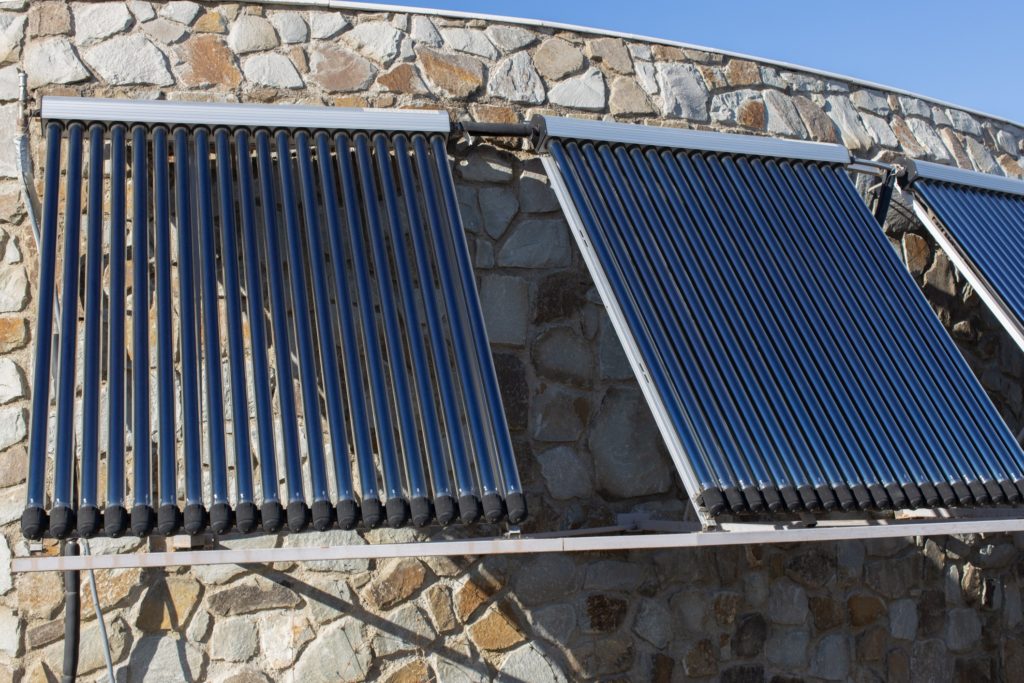
Pros & Cons: Solar thermal panels are entirely passive, electricity-free, and 100% green and renewable. However, they also have their limitations. As these systems are exposed to the elements, they don’t function well in colder climates where low air temperatures eliminate many of the benefits of solar heating. If you use hot water in faucets and showers, it’s also essential to remember that these systems have limited capacity. They can take a while to heat up again once depleted.
Best For: Those in milder climates looking for an electricity-free method that also heats their hot water.
How It Works: For off-grid homeowners who want to get back to the basics, wood and pellet stoves offer a low-tech, relatively low-cost method for heating. There’s not much to explain in terms of operation. Place your wood or pellets in the stove, and light them.
In many cases, the radiating heat is enough to heat large rooms. Connecting the stove to any nearby masonry or brick can create an additional heating element. Some can also purchase an automatic pellet stove where a feeder automatically adds pellets to the fire, either at a set rate or in response to temperature changes. Keep in mind that these automatic versions will require additional electricity to operate.
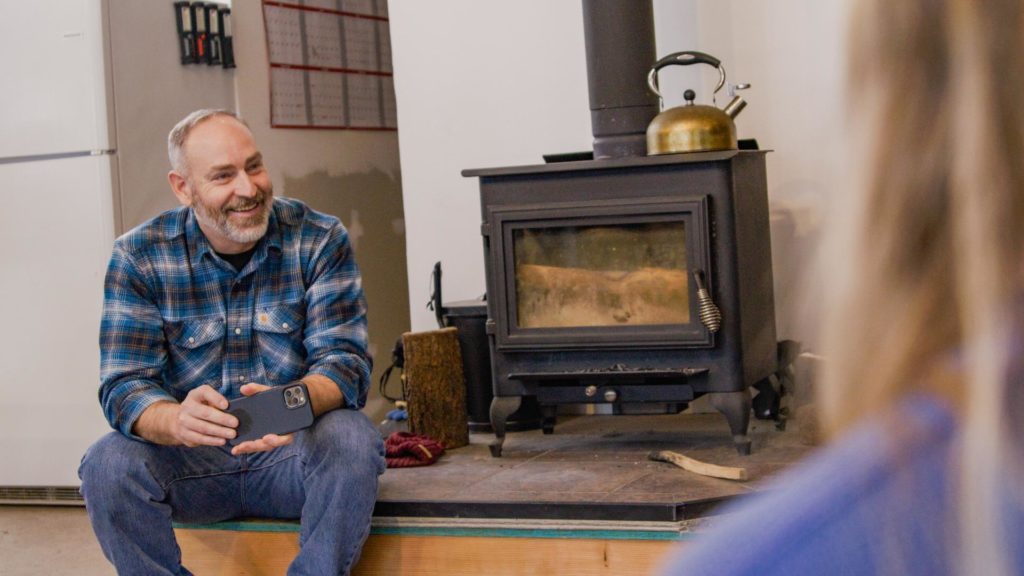
Pros & Cons: Wood and pellet stoves are reasonably affordable initially and cheap to operate. All you’ll need is wood or pellets and an occasional cleaning for safety reasons. They’re simple to use and require no outside electricity for most models. However, those using a wood or pellet stove without an automatic feeder will need to add wood to the fire by hand to keep it running and at the proper temperature. This kind of stove can also take a bit to warm a larger room, meaning they’re not the best choice for those who need immediate temperature control.
Best For: Those with easy access to wood or pellets looking for a cheap and straightforward heating method and who don’t mind having to feed the fuel by hand.
How It Works: Biomass boilers take the traditional boiler heating method and remove the fossil fuels used to run it. Instead, these boilers burn any kind of biomass. That includes biological materials like logs, branches, straw, plant matter, or other burnable natural items.
They can also run via commercially purchased wood or wood chips. Feed these elements into the boiler by hand, and the boiler will transfer the heat to hot water. This hot water releases heat through radiators or into a central heating system. In some cases, it’s also available via the plumbing system.
Pros & Cons: In ideal circumstances, those using a biomass boiler can heat their off-grid home for free. They can use materials found or harvested near their home to feed the boiler. It doesn’t get much greener and more sustainable than that!
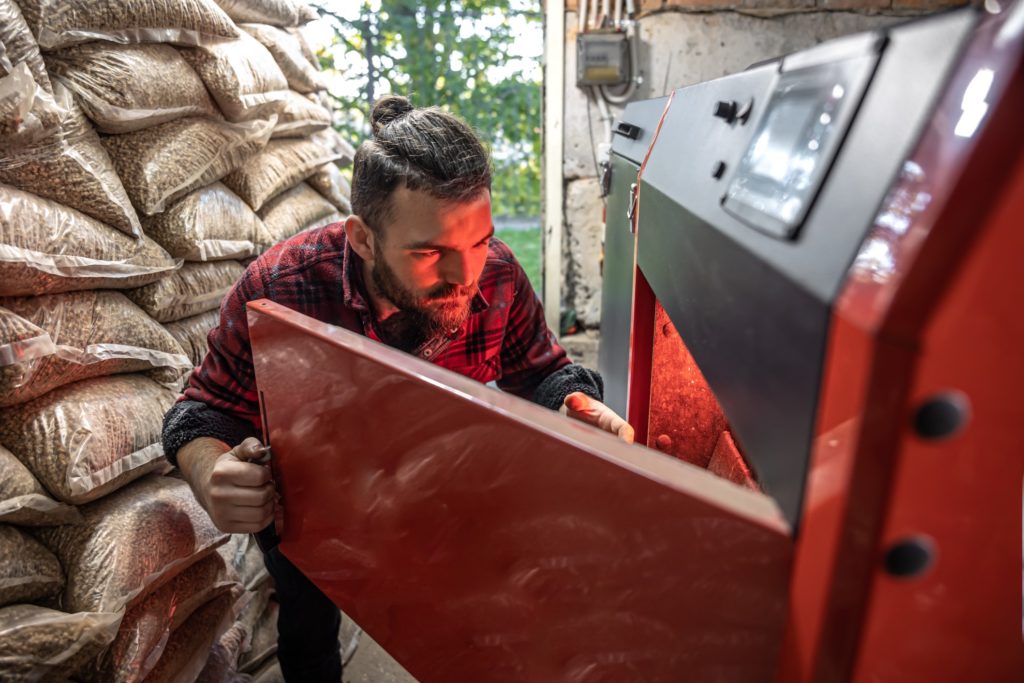
However, finding enough free fuel can require significant time spent scavenging. You might have to purchase wood or chips, adding to your heating costs. It’s also crucial to remember that these boilers need to be fed by hand. This could range from a minor annoyance to a major hassle, depending on your situation.
Best For: Those looking for an ultra-green heating source that eliminates the need for external fuel sources outside your property.
Putting all your eggs in one basket when it comes to off-grid heating can be a disaster waiting to happen. What if you can’t get fuel for your propane heater or wood stove? What if a tech issue knocks your solar energy offline? Backups are critical when living off-grid, and heating can literally be a matter of life and death.
If you rely on an electric heating method, keep some wood or propane around just in case. If you generally heat your home through a stove, a small electric heater capable of running on your power system can be an essential piece of a backup system. Having multiple options means that even when things go wrong, you’ll stay safe and comfortable even when things go wrong.
Just because a house is off the grid doesn’t mean residents shouldn’t enjoy all the comforts of home. With these six methods, just about any homeowner can find a perfect combination for their off-grid heating needs. Though they all have their advantages and drawbacks, understanding each is crucial to making the most of your off-grid life.
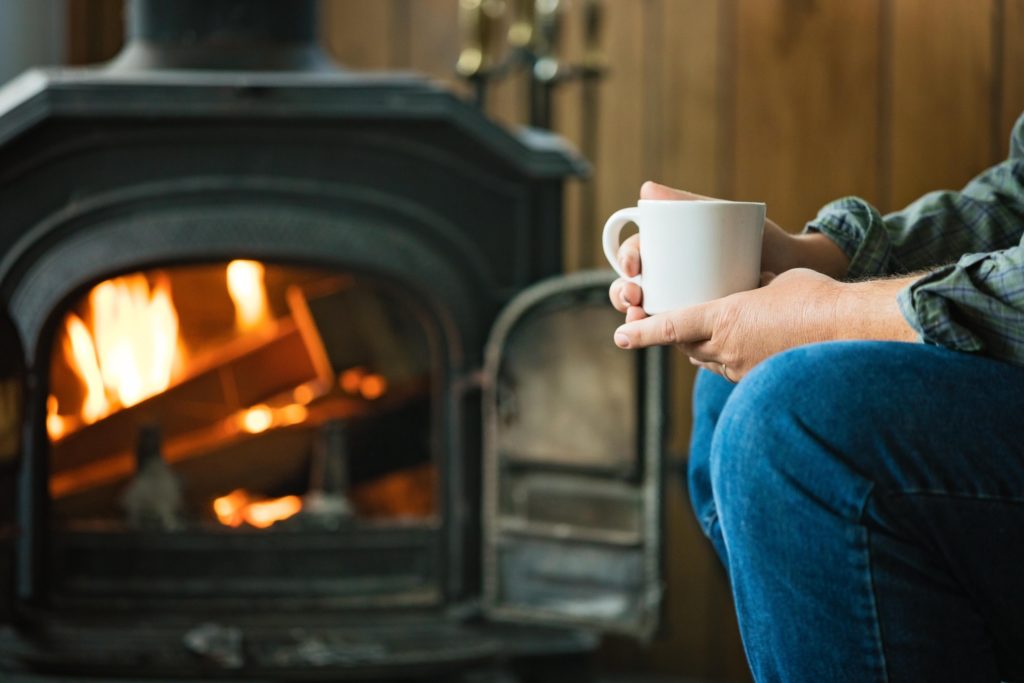
We know that building or upgrading an electrical system can be overwhelming, so we’re here to help. Our Reno, Nevada-based sales and customer service team is standing by at (855) 292-2831 to take your questions!
Also, join us on Facebook, Instagram, and YouTube to learn more about how lithium battery systems can power your lifestyle, see how others have built their systems, and gain the confidence to get out there and stay out there.
Shop Best Sellers

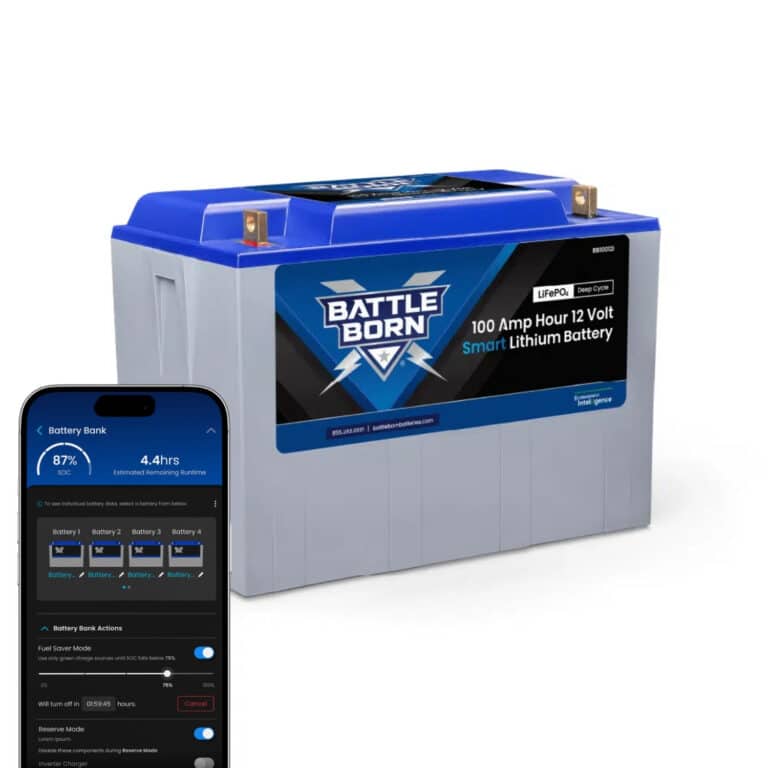

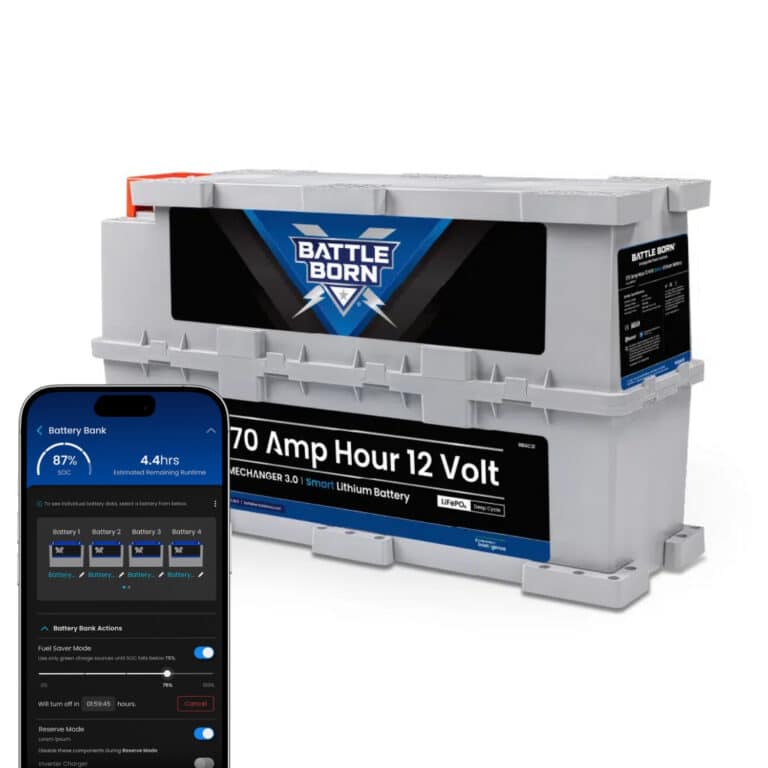




Ask a technical specialist now at 855.292.2831
Stay in the Know
Take our short Customer Survey for a chance to …
WIN a $300 Visa Gift Card